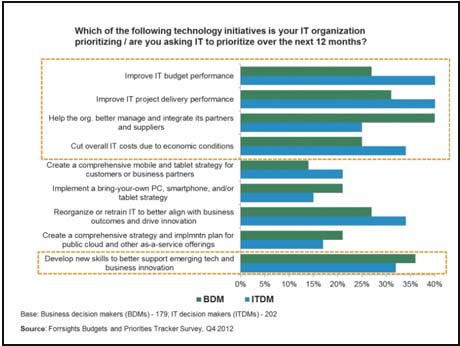
Manish Bahl, Forrester analyst and VP & Country Manager serving Vendor Strategy Professionals, in a recent blog, highlights a new and possibly significant dichotomy in India, between business decision makers or BDMs in an enterprise and the CIO or Infotech head.The decision makers seek to harness new technologies like Cloud, Mobility and Social Media, while the IT heads ( we used to call them EDP managers once!) seem caught in a time warp, still focussed on IT budgets.
We believe the blog raises some important issues for the India infotech industry -- which is why we are carrying Manish's blog in its entirety below with his permission - Ed. IndiaTechOnline
Data from the Forrsights Budgets and Priorities Tracker Survey, Q4 2012 highlights the increasing gap between CIOs and business decision-makers (BDMs) in India — a gap that originates in misaligned perspectives. The rapid rise of social media, cloud computing, and mobility in India has started to significantly affect how organizations do business in the country. Business leaders’ use of consumer technology has changed their expectations of how enterprise IT should be harnessed. They increasingly seek to use technology in innovative ways in order to gain a competitive edge and drive business growth. However, most CIOs are still caught in the old world of focusing exclusively on IT budgets and project delivery performance issues:
I recently spoke with a few CIOs in India to explore their views on the reasons behind this misalignment. When I shared data from the chart above and asked their opinions on the insights, some interesting findings that came out:
· There are many “heads of IT” and few “business technology (BT) CIOs” in India. One CIO from a large auto manufacturing firm mentioned that a majority of CIOs in India are actually “IT heads” who think and act mainly from an IT perspective. Even worse, their thinking is generally very hardware-centric. This CIO’s opinion is in sync with my recent report highlighting the fact that Indian CIOs are at risk of losing business credibility (and eventually their jobs) if they do not improve their understanding of BT.
· The few CIOs who are BT-ready do not have BT-ready teams. The CIO of a retail firm shared his struggles making his IT team BT-ready. His key challenges include the lack of a business-oriented mindset, little or no business knowledge-sharing within the team, and people becoming complacent with the old way of doing things.
· New project scopes are weak, without enough brainstorming with business leaders. Generally, project scope is unclear due to minimal brainstorming with business functions and is based on generic material, usually collected through Google. The results are unrealistic and lofty objectives that IT can’t actually meet, which further deepens the gap between business and IT.
· Systems integrators (SIs) are failing to add business value. This is a key finding from my latest report, which highlights how SIs are failing to meet the expectations of Indian CIOs. CIOs now expect an increased level of business maturity from SIs, but most SIs are not adjusting their people, offerings, or engagement models sufficiently in response.
These issues highlight the fundamental shift that Indian CIOs need to adopt in their approach to make themselves, their team, and technology vendors that they engage future-ready. While the urgency of supporting business growth is especially high among Indian CIOs, their understanding and appreciation of BT remains relatively low. The sobering truth is that business results — not technology products or solutions — will differentiate CIOs in the eyes of business leaders. Has your firm figured this transition out, or is it struggling?February 19 2013